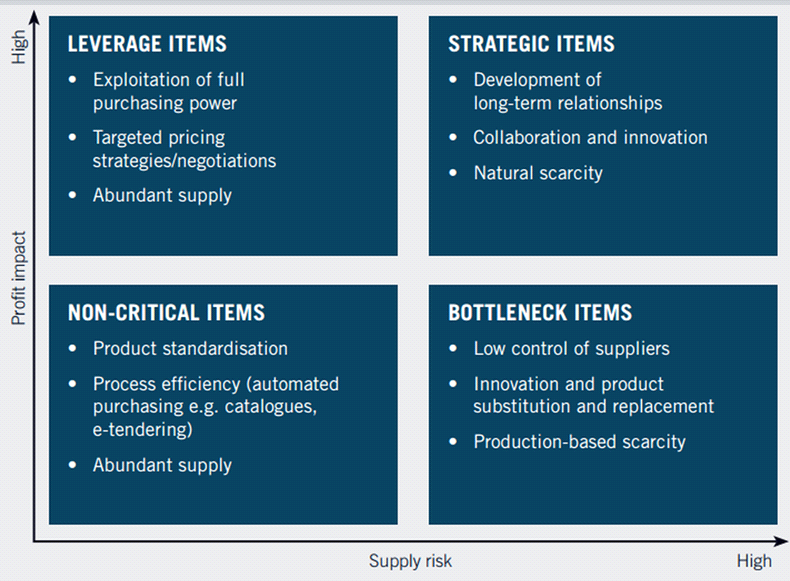Curious about Actual CIPS Level 4 Diploma in Procurement and Supply (L4M2) Exam Questions?
Here are sample CIPS Defining Business Needs (L4M2) Exam questions from real exam. You can get more CIPS Level 4 Diploma in Procurement and Supply (L4M2) Exam premium practice questions at TestInsights.
Why should procurement professionals develop business case before seeking approval to purchase capital equipment?
Correct : D
A business case is developed during the early stages of a project and outlines the why, what, how, and who necessary to decide if it is worthwhile continuing a project. One of the first things you need to know when starting a new project are the benefits of the proposed business change and how to communicate those benefits to the business.
Preparing the business case involves an assessment of:
- Business problem or opportunity
- Benefits
- Risk
- Costs including investment appraisal
- Technical solutions
- Timescale
- Impact on operations
- Organizational capability to deliver the project outcomes
These project issues are an important part of the business case. They express the problems with the current situation and demonstrate the benefits of the new business vision. Making business case with multiple options and choices also prompts the procurement and senior management to consider alternatives. As a result, the organisation may opt out the best option.
The business case brings together the benefits, disadvantages, costs, and risks of the current situa-tion and future vision so that executive management can decide if the project should go ahead.
- CIPS study guide page 19-21
- How to Write a Business Case - Template & Examples | Adobe Workfront
LO 1, AC 1.1
Start a Discussions
A drawing is an example of...?
Correct : B
A technical specification details the standards that a product or service must meet. Drawings (often called engineering drawings or technical drawings) are complementary to technical specifications
LO 3, AC 3.1
Start a Discussions
What is the output of regression analysis?
Correct : C
Regression refers to a quantitative measure of the relationship between one or more independent variables and a resulting dependent variable. Regression is of use to professionals in a wide range of fields from science and public service to financial analysis.
To perform a regression analysis, a statistician collects a set of data points, each including a com-plete set of dependent and independent variables. For example, the dependent variable could be a firm's stock price and the independent variables could be the Standard and Poor's 500 index and the national unemployment rate, assuming that the stock is not listed in the S&P 500. The sample set could be each of these three data sets for the past 20 years.
On a chart, these data points would appear as scatter plot, a set of points that may or may not appear to be organized along any line. If a linear pattern is apparent, it may be possible to sketch a line of best fit that minimizes the distance of those points from that line. If no organizing axis is visually apparent, regression analysis can generate a line based on the least squares method. This method builds the line which minimizes the squared distance of each point from the line of best fit.
Line of best fit is one of the most important outputs of regression analysis.
- CIPS study guide page 99-100
- Line Of Best Fit (investopedia.com)
LO 2, AC 2.3
Start a Discussions
A company buys components from its supplier. However, the supplier has not sent the invoice to the buyer and the buyer will not pay until next month. How will that amount of money be shown in the financial statements of the buying organization?
Correct : A
The buyer won't pay the supplier until next month. This is a liability to the buyer. This amount can be recorded as accrued expense or accounts payable. On the other hand, the supplier has not sent the invoice, so it should be accrued expense.
Both accounts payables and accrued expenses are liabilities. Accounts payable is the total amount of short-term obligations or debt a company has to pay to its creditors for goods or services bought on credit. With accounts payables, the vendor's or supplier's invoices have been received and recorded.
On the other hand, accrued expenses are the total liability that is payable for goods and services that have been consumed by the company or received. However, accrued expenses are those bills in which an invoice or bill has not yet been received. As a result, accrued expenses can sometimes be an estimated amount of what's owed, which is adjusted later to the exact amount, once the invoice has been received.
Conversely, accounts payable should represent the exact amount of the total owed from all of the invoices received.
- CIPS study guide page 55-56
- Understanding Accrued Expenses vs. Accounts Payable (investopedia.com)
LO 1, AC 1.4
Start a Discussions
A company has a lists of items that make up 15% of total spend. These items also do not largely impact on quality of final product. The supply continuity is secured. Which of the following will be the most appropriate managing approach to purchase these items?
Correct : B

Those items make up small portion of spend and the supply risk is low. So it is tactical item according to Kraljic portfolio matrix. Procurement should bundle these items into larger contracts, simplify procurement process.
LO 2, AC 2.1
Start a Discussions
Total 238 questions